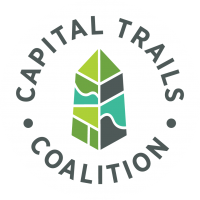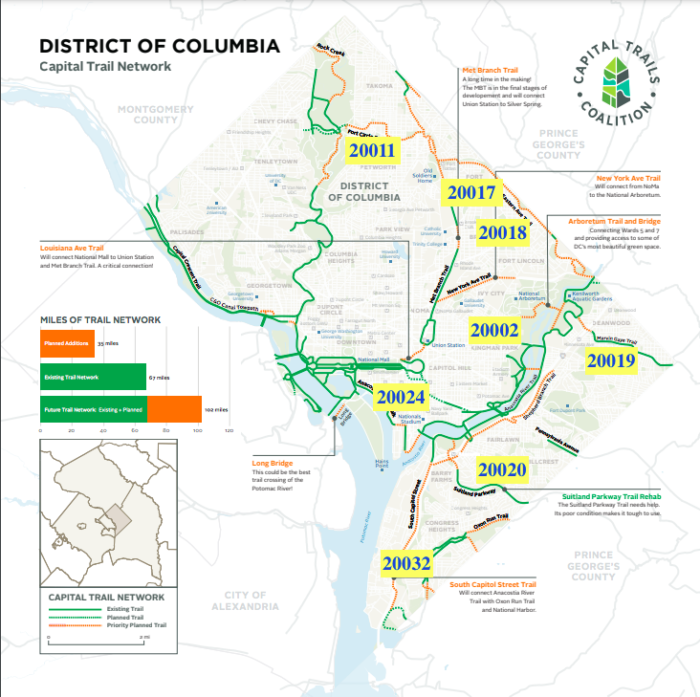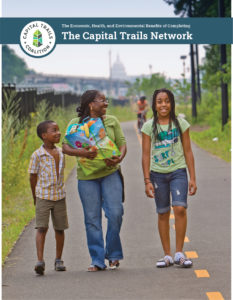In September 2020, Washington Area Bicyclist Association (WABA) and Rails-to-Trails Conservancy (RTC) conducted a focus group to better understand trail awareness and safety among DC area residents and to understand barriers (those real and perceived) that may prevent residents from utilizing trails more regularly. The research was funded by the WABA DC Trail Ranger program funded by DDOT, and Rails to Trails Conservancy.
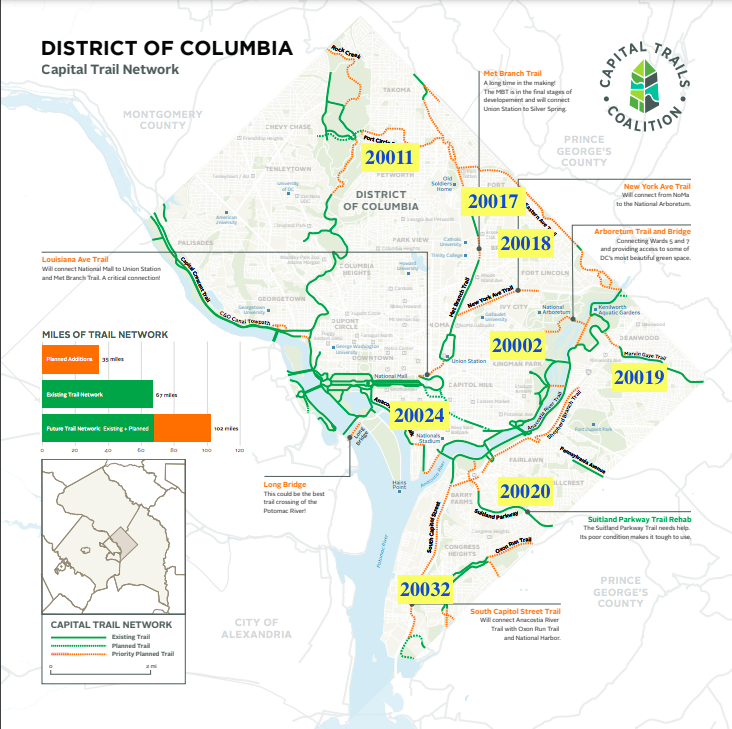
The participants in the study were largely from Wards 4, 5, 6, 7, and 8 with 43% being from the priority zip codes highlighted in Figure 1. Of the 21 participants, 52% identified as Black, 33% identified as white, 10% identified as Asian/Pacific Islander, and 5% identified as ‘Other.’ 48% of participants identified as trail-users while the majority and remaining 52% identified as trail non-users. 33% of the participants identified as male and 67% identified as female (note: the study incorrectly used gender binary for this demographic question).
As a whole, regardless of location, the respondents believed that trails contribute to the well-being of their community, and the top cited reasons for trail use were to enjoy nature, to get physical exercise, and to use as a means of relaxation. In fact, in both the pre- and post-focus group survey, everyone thought trails were positive, and the number of individuals who felt that trails contribute ‘a great deal’ to their well-being increased after having participated in the focus group. Just talking about trails increased their importance to individuals in the community!
| Level of perceived contribution | Pre-focus group | Post-focus group | Change in number of responses |
| A great deal | 29% | 38% | +10% |
| A lot | 19% | 14% | -5% |
| A moderate amount | 33% | 33% | 0% |
| A little | 19% | 14% | -5% |
| Not at all | 0% | 0% | 0% |
Overall Results showed that trail users find spending time outdoors more important than trail non-users, but even with 52% of the respondents identifying as trail non-users, 82% of all participants reported interest in spending time on trails if they had access. However, citing interest in trail use and outdoor recreation does not guarantee accessibility, ease of use, and/or awareness of opportunity. Even though the zip codes represented in the study are in Northeast, Southeast and Southwest DC, apart from the Anacostia River Trail (ART), Rock Creek Park Trail (RCPT) was mentioned by participants the most without prompting – trails like Oxon Run and Marvin Gaye were far less known. Because no one mentioned these two trails unprompted, we wanted to gauge the level of awareness of these trails. We found that of the participants representing the 8 target zip codes, less than half (40%) were aware of trails in their neighborhood, while 30% were unsure, and 30% were completely unaware of the Oxon Run and Marvin Gaye Trails. Mere lack of awareness could be a large barrier to trail use, and we believe the Anacostia River Trail (ART) and Rock Creek Park Trail (RCPT) are more well known because they cover more mileage and touch more neighborhoods. The ART and RCPT are also likely recognized more because of their “name brand” status. Because of this, we believe that increasing name recognition of various trails in the area could lead to increase in trail use! (If you’re interested in learning more about either site, you can check out DPR who manages Marvin Gaye Trail or DDOT who manages the Oxon Run Trail!)
Though many individuals may know about trails, they may not use them because they don’t feel that “trails are for them.” The focus group found that there is a common perception among trail non-users that trails are primarily for “outdoorsy people” – those who enjoy walking, biking, and being in nature. If someone doesn’t identify as an “outdoorsy person” they may not feel as welcome, or that they belong on a trail. Participants were asked to share who they felt were individuals not welcome on trails. Broadly, white participants feel those misusing the trail, and exhibiting inappropriate behavior to be individuals not welcome on trails. Black participants more often alluded to those identifying with their community as being less welcome due to worry about other’s perceptions of them as well as the fear of experiencing race-based discrimination and violence. The participants in this study overwhelmingly identified as Black or white, so we cannot confidently conclude how non-Black people of color’s experiences and understanding of DC trails may differ.
The idea that others perceptions are negative can be a huge deterrent to trail use in marginalized populations as it leads to feeling uncomfortable and unwelcome. Additionally, Black participants noted a fear of white trail users acting on negative thoughts and threatening Black trail users. One participant identifying as a 38 year-old Black male and trail non-user said:
“Black people in general are not drawn to trails… People in my neighborhood would actually think it strange for me to say I was going to spend some time on the trail. It is not taught as children.”
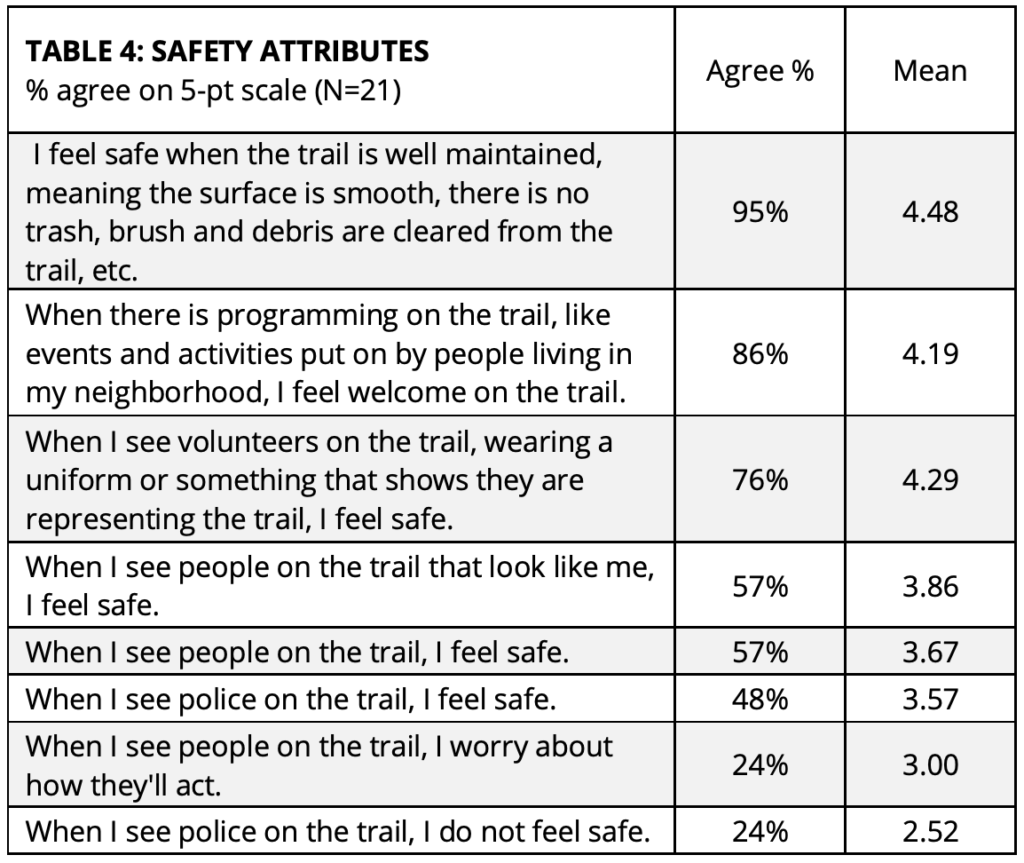
Another barrier to trail use was a concern about the level of safety and frequency of crime and violence on trails. None of the participants had ever had first hand experience of crime or violence while on a trail, but a number of respondents, women especially, cited this as a reason that they may avoid trails. What participants cited as safety attributes often aligned with whether or not a participant identified as a trail user. Participants identifying as trail users often indicated that they feel safest when on a trail that is well maintained – one with a smooth surface, no trash, and with brush and debris cleared from the trail. Participants who identified as trail non-users more often cited safety attributes as those including programming along the trail – such as events and activities that are put on and run by individuals in the community, creating a more welcoming environment – and when people in uniform are visible (like the WABA Trail Rangers). Trail non-user respondents also reported that seeing individuals on the trail that look like them attributed to feeling safer, as well as seeing other people in general.
In summary, some of the key findings were that discussion and awareness amplified the perception of positive impacts of trails among participants even if they already believed that trails contributed positively to their well-being. Concerning safety, most concerns noted were perceptions instead of actual negative experiences, and these perceptions varied across groups (e.g. women indicated a fear of harassment on trails while no men in the study cited this as a fear they experience). Further, a key takeaway of the study was that for many, trails are seen as the actual destination – not just a means of reaching a destination. People want to travel to a trail for the sake of being on a trail and not just to use it as a means of transportation!
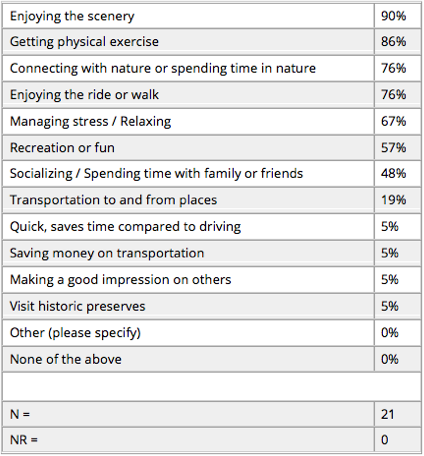
Moving forward, to increase trail use across all groups, and keeping in mind that the DC area is one full of diversity including many communities with varying needs, we are looking for ways to promote the intrinsic destination value of trails, increase culturally specific programming (trail rangers/ambassadors highlighting recreation, getting close to nature, physical activity, and wellness specific to every community) and promote inclusivity on trails through public messaging and programming that is representative of local demographics. It is our hope that we can use the information gained from the focus group to improve the level of trail awareness, perceptions of safety, and the extent to which individuals feel trails are an important part of their lives to consequently improve overall trail use for transportation, recreation, and relaxation!
Please find our presentation to CTC Members on the focus group results here.
If you have any thoughts, suggestions, etc. please feel free to reach out to Stephanie Piperno at advocacy-team@waba.org – we’d love to hear your ideas!
